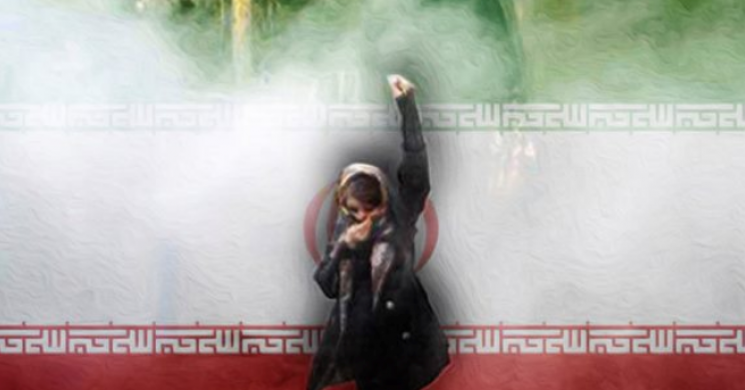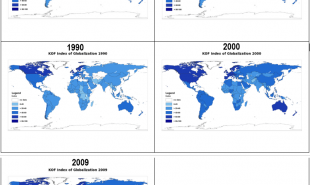
January 2, 2018 at 12:53 pm
Written by Darius Shahtahmasebi
(ANTIMEDIA Op-ed) — Over the past week, Iran has been hit with series of protests, reportedly in relation to the country’s current economic climate. Where this particular narrative is headed is of major concern because of the current atmosphere in the Middle East and its deadly dynamics.
Approximately two weeks ago, the truth about U.S. foreign policy was revealed in a leaked memo that purportedly coached Secretary of State Rex Tillerson on how to use human rights as a pretense to attack America’s adversaries.
“Allies should be treated differently — and better — than adversaries. Otherwise, we end up with more adversaries, and fewer allies,” stated the memo, which was written by Tillerson’s influential policy aide, Brian Hook.
As part of the U.S. foreign policy playbook, in June 2017, Tillerson himself confirmed that official U.S. policy towards Iran included a regime change strategy. He said:
“We continually review the merits both from the standpoint of diplomatic but also international consequences of designating the Iranian Revolutionary Guard in its entirety as a terrorist organization. As you know, we have designated the Quds [Force]. Our policy towards Iran is to push back on this hegemony, contain their ability to develop obviously nuclear weapons, and to work toward support of those elements inside of Iran that would lead to a peaceful transition of that government. Those elements are there, certainly as we know.” [emphasis added]
Around the same time, the Trump administration appointed Michael D’Andrea, the CIA’s “Dark Prince,” to head the CIA’s “Iran operations.” Given the CIA overthrew Iran’s democratically elected government in 1953, relying almost completely on one die-hard agent to do so, this program’s trajectory should be clear.
Barely days after D’Andrea’s appointment, Iran was coincidentally rocked by an ISIS-inspired attack. Republican congressman Rep. Dana Rohrabacher suggested the attack was “a good thing.”
In December, CIA director Mike Pompeo admitted he sent a letter to General Qassem Soleimani, a stalwart leader of the Islamic Revolutionary Guard Corps (IRGC), saying he will hold Iran and Soleimani “accountable” for any attacks on Washington’s interests in Iraq. This is the same IRGC commander who announced Iran would begin supporting Palestinian forces in the Gaza strip after Trump’s infamous Jerusalem debacle.
Unsurprisingly, U.S. intelligence agencies reportedly just gave the green light to Israel to assassinate this commander, a clear act of war.
The timing of the current protests has coincided with reports that the U.S. and Israel formulated a joint plan to specifically target Iran. This coincides with Nikki Haley’s grandiose anti-Iran performance, which has been full of deceit and hawkish propaganda. Further, Israel hopes these protests will be an opportunity to take the Iranian government’s attention away from Israel, according to a top intelligence expert.
Even without Iranians taking to the streets, it is clear that the Trump administration and its regional allies have been planning to take the fight to Iran.
Discerning the Truth About the Recent Protests
What should we make of the recent protests sweeping the country?
Even according to the mainstream media, the protests are not exactly what they seem. Iran’s president acknowledged that Iranians have a right to peaceful protest and that the protesters are not necessarily guided by foreign elements as “a number of them are the people who came to the streets because of their (economic) problems.”
“Criticism is different [from] violence and destroying public property,” he also reportedly said.
According to Haaretz, the protests were initially riled up by Iran’s conservative hard-line opposition to put pressure on the current Iranian president, who is considered a moderate. The protesters are not necessarily the democracy-seeking students the media has portrayed them as.
The mainstream media further acknowledged that the Iranian authorities are actively trying to avoid a massive crackdown. From Slate:
“It seems clear that Iranian leaders are trying to avoid a massive crackdown of the surprisingly large protests for now, worried that any huge repression could lead to a crisis similar to what took place in 2009.”
As Reuters explained:
“Iranian moderates are appealing for caution even though some hardliners are calling for an iron fist to crush one of the gravest threats to Iran’s clerical leaders, who came to power in the 1979 Islamic revolution.
“Those divisions are making it hard for the authorities to defuse spontaneous demonstration, especially as there are no apparent protest leaders who can be identified and rounded up.”
The media is still treating the videos of anti-government protesters shouting “Death to the dictator!” as “unconfirmed,” meaning they haven’t been properly verified. Or consider this recent Reuters report, which stated the following:
“Mohsen Nasj Hamadani, deputy security chief in Tehran province, said about 50 people had rallied in a square but most had left after being asked to by police, while a few who refused were ‘temporarily detained,’ the ILNA news agency reported.”
Carl Bildt, former Swedish prime minister and co-chair for the European Council on Foreign Relations quickly took to Twitter to state that there were “[r]eports of signals of international satellite TV networks jammed in large cities of Iran. Would be sign of regime fear of today’s protests spreading.” However, the only reports that can be found online of jammed international TV networks are from at least five years prior to the current unrest. Not surprisingly, Wikileaks cables suggested Bildt served as a U.S. government informant when he was just 27 years old.
In other words, it would pay to be overly meticulous when following the reports on this intricate topic.
To be clear, the protests are not nearly as concerned with Iran’s foreign policy as much as some media outlets are claiming they are. As the Atlantic explained:
“Unlike what President Trump suggests, the protests aren’t about Iran’s broader behaviour and foreign policy. And they’re not about the regime’s support for terrorism…their main concern lies in the price of day-to-day items and goods, such as poultry and eggs, as well as unemployment and access to services.”
The death toll in the protests and the authorities’ inevitable response quickly grew to at least 12 — a damning statistic for the Iranian government. However, whether the following allegations are true or not, the mainstream media has acknowledged that deaths occurred as a result of confrontation, specifically, the claim that armed protesters began storming military bases and police stations. Other government compounds were stormed, as well, with protesters lighting fires in government offices.
These are no longer students who are complaining about the price of eggs or the right to dress in modern clothing (in a remarkable coincidence, just before the protests erupted, Tehran’s police stated they would no longer arrest women for violating the Islamic dress code). Overrunning military bases and police stations with arms doesn’t make you a protester, it makes you a militant. As journalist Ben Norton wrote on his Facebook page, “If ‘armed protesters’ (quite a phrase) tried to overrun military bases and police stations in the US, it would declare martial law.”
Things may not be so dire in Iran to require an armed uprising just yet (just take a look at the thousands of pro-government supporters who have rallied the streets of Iran’s major cities). It would be disingenuous to pay sole attention to the anti-government protesters while ignoring the thousands of those who do support their government. This is not to say that Iranians do not have genuine cause to take to the streets and protest, but it certainly gives good cause to the international community that perhaps — just this once — it would do well to mind its own business.
Even according to some of the biggest corporate media outlets, there is likely foul play if people are taking arms against the Iranian government in the current circumstances. As the New York Magazine acknowledged:
“As The Guardian and New York Times point out, small protests focused on economic issues are normal in Iran, but politically charged protests across the country where people feel safe chanting ‘death to the dictator’ — a knock on Supreme Leader Ali Khamenei — are not. The protests will undoubtedly be an important test for the relatively moderate Rouhani, who has not been spared as a subject of chanting at the rallies; in his remarks on Sunday, Rouhani was clearly trying to walk a delicate line. There is also apparently suspicion among members of his administration and other reformers about what forces may be behind the unrest.” [emphasis added]
The West’s Hypocrisy is Staggering
Despite this, Donald Trump was quick to take to Twitter to condemn Iran and voice his support for the protesters. State Department spokeswoman Heather Nauert also said in a statement that the U.S. urged “all nations to publicly support the Iranian people and their demands for basic rights and an end to corruption.”
This is the same administration that banned the Iranian people from merely visiting the United States.
Even Hillary Clinton voiced her support for the Iranian people currently protesting against the government. Apparently, Clinton has forgotten about the video of her where she broke into hysterical laughter while talking about the U.S.’ desire to launch a war against Iran, which would undoubtedly kill hundreds of thousands of ordinary Iranians.
We would also do well to remember that after Donald Trump was elected U.S. president at the end of 2016, America was inundated with anti-Trump protests. Los Angeles police arrested at least 462 people at the time. America’s NATO ally Turkey arrested, detained, suspended, and fired tens of thousands of teachers, lawyers, military officers, and court officials (with at least 249 deaths in total) – and yet Donald Trump has only appeared to praise the Turkish government’s crackdown.
America’s Middle Eastern darling, Israel, has also been rocked by thousands of protesters participating in anti-corruption marches specifically targeting Israeli Prime Minister Benjamin Netanyahu. Israel also infamously locked up a young teenage girl who was brave enough to slap an Israeli soldier who had invaded her home.
For the sake of argument, let’s all agree that Iran’s protests are genuine. That fact alone isn’t grounds for an illegal regime change operation given the international standards the rest of the world has been operating under for years. Allowing Trump to take the protests for a ride to serve his own ludicrous foreign policy agenda also undermines the intellect and history of Iran and its people, as the Atlantic explains:
“Iranians aren’t ‘finally’ waking up and ‘getting wise,’ as Trump suggests. Instead, Iran has a dynamic and active civil society, which has created and embraced opportunities for reformation and progress for decades…And many Iranians have paid for these ideals with their lives.”
Don’t buy into the hypocrisy. Donald Trump does not care about ordinary Iranians, and he certainly doesn’t care about Iran’s access to democracy. If Donald Trump cared about the Iranian people’s economic concerns, the simple solution would be to stop unilaterally slamming the country with economic sanctions on a routine basis.
In the words of the Atlantic, Donald Trump “barely understands the country he’s repeatedly demonized.”
We’ve been here before. The groundwork is being laid for a direct confrontation with Iran, and we are naïve at best if we decide to take the bait. America’s footprint in the Middle East was never rooted in any concerns for human rights, and believe it or not, America’s interests and desires are always rooted in money.
The last thing Iran needs right now in order to move towards a more democratic and economically viable country is the direct interference of the United States, a country that has reportedly killed over one million Muslims since the 9/11 attacks.
If the Iranians want to exact change; they can and will do it themselves. As stated by the Tudeh Party of Iran, an Iranian communist party formed in 1941:
“It should be noted that under the critical conditions of the current dangerous regional tensions, the regional reaction – supported by the Trump administration in the US and the right-wing government of Netanyahu in Israel – is seeking to distinctly impact the developments in our country and to replace the current reactionary regime with another reactionary regime.
“The support of these forces…for the Iranian monarchists and those political groups whose agenda is to cooperate with the most reactionary regimes of the region and to persuade the European states to impose sanctions on Iran’s economy – thereby exacerbating the misery for the destitute and disadvantaged people of our country – and to encourage foreign states to interfere militarily in Iran, leaves no room whatsoever for any optimism regarding the future designs of such ‘opposition’…We should not let the past repeat itself whereby the heroic struggle of the nation for freedom, democracy and social justice is hijacked by a bunch of reactionary opportunities who do not believe in the people’s rights or democratic freedoms.”
Correction: A previous version of this article stated the Trump administration was behind the arrests of protesters in Los Angeles after his election in November 2016. It has been corrected to reflect that while police arrested protesters, they did not do so at the direction of the Trump administration as he had not yet taken office. Protesters at his inauguration, however, were arrested and have gone on to face charges this year.
Read more by MarketSlant Editor







